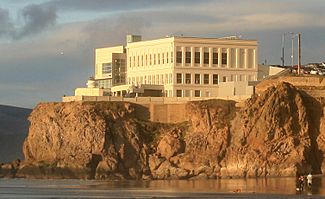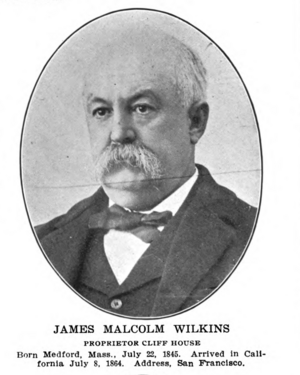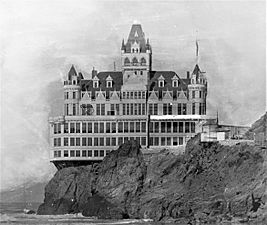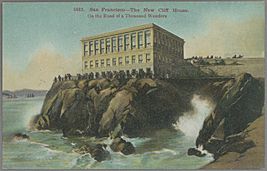Cliff House, San Francisco facts for kids
Quick facts for kids Cliff House |
|
|---|---|

Cliff House from Ocean Beach, 2010
|
|
| Lua error in Module:Location_map at line 420: attempt to index field 'wikibase' (a nil value). | |
| Restaurant information | |
| Established | 1863 |
| Street address | 1090 Point Lobos Ave |
| City | San Francisco |
| State | California |
| Postal/ZIP code | 94121 |
| Coordinates | 37°46′42″N 122°30′50″W / 37.778394°N 122.513935°W |
The Cliff House is a beautiful building in a classic style that sits high on the cliffs above Ocean Beach in San Francisco. It's located on the city's west side, looking out over the old Sutro Baths ruins and Seal Rocks. This special spot is part of the Golden Gate National Recreation Area and is managed by the National Park Service (NPS). The Cliff House even has a room-sized camera obscura on its terrace, which is a cool way to see the ocean views!
For most of its long history, since 1863, the Cliff House has been famous for its restaurants and bars. People loved to visit and enjoy amazing views of the Pacific Ocean. Since 1977, private companies have run these restaurants under a contract with the National Park Service. In December 2020, the company that had been running the restaurants for 47 years closed its doors. The National Park Service is now working to find a new operator for this historic location.
Contents
The First Cliff House (1863–1894)
Some stories say that Samuel Brannan built the first Cliff House in 1858 using wood from a shipwreck. However, there isn't clear proof that this building ever existed.
The first official Cliff House was built by Senator John Buckley and C. C. Butler. It opened in 1863 and was first managed by Captain Junius G. Foster. At first, it was a long trip from the city, so mostly horseback riders and picnickers visited.
A year later, a private toll road called Point Lobos opened. This made the Cliff House a popular Sunday spot for people with horse-drawn carriages. Later, a two-mile speedway was built next to the road where wealthy San Franciscans raced their horses. Soon, public transportation like omnibuses, railways, and streetcars made it easier to reach the beach. Many people came to visit Golden Gate Park and see the sea lions resting on Seal Rocks near the cliffs. In 1877, the city bought the toll road, which is now Geary Street.
In 1883, Adolph Sutro bought the Cliff House. He had become rich from silver mining. After a few years, the Cliff House was badly damaged in 1887 when a ship carrying dynamite exploded nearby. The blast was heard far away and destroyed part of the building. It was repaired, but then a fire completely destroyed it on Christmas night in 1894. The owner, James M. Wilkins, couldn't save the guest book, which had signatures from three U.S. Presidents and many famous visitors. This version of the Cliff House had lasted for 31 years.
The Second Cliff House (1896–1907)
In 1896, Adolph Sutro rebuilt the Cliff House. It was a grand, seven-story Victorian building, sometimes called "the Gingerbread Palace." It sat below his estate at Sutro Heights. This was also when work began on the Sutro Baths, which were huge indoor swimming pools, a museum, and a skating rink located just north of the restaurant. Many San Franciscans would arrive by steam train, bicycle, or horse-drawn wagons for Sunday trips. Sutro even bought collections of stuffed animals and artwork from Woodward's Gardens to display at both the Cliff House and Sutro Baths.
The 1896 Cliff House survived the great 1906 earthquake with only minor damage. However, it burned down completely on September 7, 1907.
The Third Cliff House (1909–Present)
Building the Current Cliff House (1909–1937)
After the fire, Emma Merritt, who was Adolph Sutro's daughter, hired architects Reid & Reid to rebuild the restaurant. They designed it in a classic style, and it was finished in just two years. This is the building you can still see today! In 1914, a travel guide called Bohemian San Francisco described it as one of the best restaurants in the city, especially for breakfast.
Changes Over the Years (1937–2003)
In 1937, George and Leo Whitney bought the Cliff House. They also owned the nearby Playland-at-the-Beach amusement park. They changed the Cliff House a lot, turning it into an American-style restaurant. From 1955 to 1966, a "Sky Tram" carried up to 25 visitors at a time across the Sutro Baths area to the Cliff House balcony.
In 1972, when Playland closed, the Musée Mécanique moved into the basement of the Cliff House. This museum has many old coin-operated arcade games from the 20th century. In the early 1970s, artists Michael Cotten and Prairie Prince painted a large mural of crashing waves on the side of the building facing the land.
The National Park Service (NPS) bought the building in 1977. It became part of the Golden Gate National Recreation Area. The NPS then hired Dan and Mary Hountalas to run the restaurants and shops. The Hountalas family continued to manage the Cliff House for many years.
Restoring the Cliff House (2003–2020)
In 2003, the Cliff House went through a big renovation. Many of the changes made by the Whitneys were removed, and the building was restored to look like it did in 1909. A new two-story section was added, overlooking the ruins of the Sutro Baths (which had burned down in 1966). During this restoration, the Musée Mécanique moved to Fisherman's Wharf.
The Cliff House had two restaurants: the casual Bistro Restaurant and the fancier Sutro's. There was also a Sunday brunch buffet in the Terrace Room. A gift shop was in the building, and the historic camera obscura was on a deck with ocean views. The Hountalas family continued to manage the Cliff House during this time.
During a government shutdown in 2013, the US Park Service ordered the restaurant to close. The owners tried to stay open but were eventually forced to close for a short time. They reopened with permission a few days later.
Recent Closure and Future Plans
On December 13, 2020, the company running the Cliff House announced they would close on December 31, 2020. They mentioned financial losses from the COVID-19 pandemic and issues with getting a new long-term lease from the National Park Service. The restaurant had been operating with short-term leases since June 2018. The National Park Service stated they offered a 3.5-year lease, but it was turned down. On December 31, 2020, the Cliff House sign was removed.
The NPS has said it wants to keep this famous building open. They are looking for a new company to run the restaurants and shops. In February 2021, the San Francisco Board of Supervisors asked the NPS to find a temporary operator quickly while they search for a long-term one. The Park Service confirmed they plan to do this.
What's in a Name?
After the Hountalas family left, it was discovered that their company owned some trademarks related to the "Cliff House" name. This made people wonder if a new company would be able to use the famous "Cliff House" name in the future.
See Also
|






